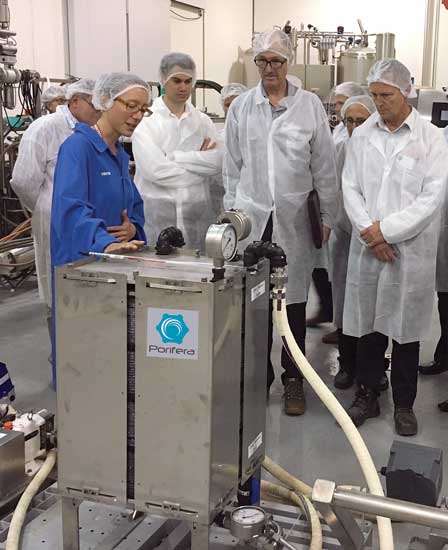Advantages and Applications of Forward Osmosis
PROCESSING
This month’s Processing column will explore the use of forward osmosis to dewater and concentrate. Forward osmosis is performed with specially designed membranes and requires very little energy. Where thermal evaporation and reverse osmosis may damage or alter products, forward osmosis preserves the sensory profile and bioactivity of the liquids it dewaters. Forward osmosis makes possible a whole new range of products that cannot be made with existing processes. The basic principles of this technology will be reviewed, as will applications in the food industry. Special thanks to my coauthors Olgica Bakajin and Jennifer Klare from Porifera Inc. for their contributions to this column.
 An Overview
An Overview
Osmosis, the migration of water, is a natural process that has been used passively for centuries in food processing for the rehydration of dried products. Lettuce soaking up water mist in a grocery store vegetable bin stays fresh and crispy due to osmotic hydration. In forward osmosis, water naturally flows out of the processed liquid through a semi-permeable membrane. The water transfer is driven by the chemical potential gradient between the liquid feed on one side of the membrane and the draw solution on the other side. The flow of water across the membrane concentrates the feed and dilutes the draw solution. Forward osmosis functions as an “osmotic pressure exchanger” whereby the draw solution is a working fluid. The forward osmosis membrane, draw solution, and operational parameters are specifically designed to maximize water transport while simultaneously minimizing energy and loss of other compounds, such as nutrients, and aromas.
Forward osmosis is distinguished from the more widely known reverse osmosis, where the feed is pressurized against the semi-permeable membrane to produce a clean permeate stream and a concentrated reject. While reverse osmosis is efficient for desalting moderate salinity solutions, reverse osmosis has trouble processing high fouling feeds due to compaction of solutes against the membrane surface, and is limited in the osmotic pressure it can reach. The strength of forward osmosis is that it can dewater feeds loaded with fibers, sugars, and salts, and it does not have any osmotic pressure limitations.
During the forward osmosis process, the draw solution is diluted and is then regenerated for reuse within the system. The draw solution is typically engineered to be a high osmotic pressure mixture of simple salts and sugars. Since the draw is clean and has no particulates or other contamination, low-energy membrane concentration processes can be used for its regeneration. Porifera Inc. uses a patent-pending process that combines forward osmosis and modified reverse osmosis to concentrate up to 50 Brix. Thermal processes can also be used for draw regeneration. Their use comes at an increased energy cost, but the forward osmosis feed liquid can still be processed at the desired temperature to preserve the quality of the product and heat exchangers can be employed to recover heat within the system.
In the past five years, there have been significant advances made in forward osmosis membrane, equipment, and process design. Thanks to those advances, forward osmosis is now an economical dewatering solution applicable across numerous industries. Companies engaged in the development of forward osmosis have recently formed an industry group, the International Forward Osmosis Assoc.
 Advantages of Forward Osmosis Dewatering
Advantages of Forward Osmosis Dewatering
• Preservation of Color, Nutrients and Sensory Profile. Membrane processes are preferred for concentrating liquids with heat-sensitive compounds. When considering the preservation of nutrients and volatiles, forward osmosis concentrates are superior to concentrates produced by thermal evaporation and by reverse osmosis. Since forward osmosis is not limited by osmotic pressure of the concentrate, it achieves substantially higher concentration than reverse osmosis. Forward osmosis can achieve concentrations comparable to those of thermal evaporation, but forward osmosis does not detrimentally affect key flavor compounds or cause browning. This preserves the color and sensory profile of the original product.
• Low Energy and Low Cost. Energy use in forward osmosis dewatering is minimal. If a draw solution is available, the process only consumes the circulation energy of the two liquids (feed solution, such as juice, and draw solution at 10 psi or less). While additional energy is required for the draw regeneration process, a properly designed system will consume significantly less energy than thermal concentration. For example, according to Porifera, less than 0.005 kWh is required per kg of water removed to concentrate coconut water to 42 Brix, compared to 30–100 kWh per ton of water for evaporators. The other operating costs of the forward osmosis process are also low because of forward osmosis’s intrinsically high tolerance for foulants.
Scientific studies have shown that forward osmosis membranes are less prone to plugging and fouling, so they require less pretreatment. Plugging and fouling are induced by pressure, used to “push” water through the membrane, compacting foulants into the membrane during the process. Forward osmosis operates without hydrostatic pressure, reducing complications arising from foulants. In addition, forward osmosis is easily deployable and affordable at small capacities and the footprint for forward osmosis equipment is considerably smaller than for evaporators. Therefore, it is conceivable to apply forward osmosis dewatering directly on a farm or by smaller producers without compromising on energy efficiency or requiring a large capital expenditure. Dewatering onsite reduces product volume, thereby lowering transportation and storage costs.
• More Water, Less Energy. In addition to using less energy for concentrated products, forward osmosis also produces a high purity water stream as a by-product. According to Porifera, in a pilot test where a product was concentrated from approximately 6 Brix and 75,000 mg/L COD to 30 Brix and 3,300,000 mg/L COD, the clean water by-product from the process measured at less than 300 mg/L TDS, 0 Brix, and between 0 and 8 mg/L COD. This water is suitable for reuse for wash-downs, boiler feed makeup, cooling tower feed makeup, irrigation, dilution of other waste streams that exceed discharge limits, or other types of high purity water reuse.
Applications of Forward Osmosis
• New Natural Concentrates. Currently, most thermally evaporated fruit juice concentrates lose color, flavor, and nutritional compounds during processing compared to fresh juices. Fruit juices dewatered by forward osmosis retain the original color, nutrients, and sensory profile. One potential application of these concentrates is to replace sugar additives with forward osmosis dewatered juice, providing vitamins, antioxidants, fiber, and other nutrients, in addition to the natural sugar. Forward osmosis concentrates can also be used to provide high quality concentrated feedstock before spray-drying to produce powdered products. High quality dehydrated vegetable juices may enable creation of entirely new lines of products. Forward osmosis also provides a more efficient and cheaper way to concentrate proteins from milk and is applicable to both heat sensitive proteins and those that are not heat sensitive.
• Transportation Savings. Concentrates enable manufacturers to save on transportation, storage, and other logistical costs. However, consumers have come to associate “juice from concentrate” with reduced quality. Forward osmosis dewatered concentrates enable transportation savings without compromising product quality. Tropical juices such as coconut water and mango, pineapple, or passion fruit juice can be concentrated five- to 10-fold prior to shipment to reduce shipping costs. If coconut water was shipped dewatered and was rehydrated at the point of sale, the annual shipping savings would amount to 3 billion tons less of water shipped, saving energy, reducing greenhouse gas emissions, and reducing costs. Cutting transportation costs by 75% could provide a net product cost reduction (or increased profit margin) of more than 30%.
Growers can also use forward osmosis to increase revenue by converting excess fruit or cosmetically challenged fruit into a high quality concentrate. Lastly, transportation savings may also be applicable in the dairy industry where the farms are far from the processing facilities.
• Dewatering of Water-Alcohol Mixtures. Forward osmosis can also be engineered to work with water-solvent mixtures such as water-alcohol. For example, forward osmosis can dewater extracts in alcohol and either maintain the alcohol in the final product or reduce it. The photograph on page 65 shows wine concentrated five-fold. The wine concentration process can concentrate the alcohol proportionally to other components or reduce alcohol and upon rehydration create a low-alcohol wine.
• Wastewater Treatment. In addition to concentrating products, forward osmosis also concentrates liquid waste while producing clean water for reuse. Due to its intrinsic tolerance to fouling, forward osmosis can concentrate hard-to-treat wastes that plug other membranes. In many cases, waste treated by forward osmosis can be turned into a high-BTU syrup that can be sold as an energy source.
Future Developments
As with any food processing technology, one of the key issues is to establish a compatible kill step for safety and to extend shelf-life. Depending on the product concentrated, high pressure processing, ultraviolet treatment, or any of the other new cold pasteurization techniques could be combined with forward osmosis to demonstrate processing that is compatible with commercial operations.
Despite its many promising benefits, forward osmosis is a new technology that is still being refined. In the next year we expect to see the first forward osmosis concentrates come to market. Additional work needs to be done to customize and optimize forward osmosis processes for specific products of interest. While forward osmosis is just now making its commercial debut, now is the right time for forward osmosis to come of age, propelled by the increased demand for high quality natural concentrates and thanks to the industry’s surge of new cold methods for sanitary control.
 Tara McHugh, PhD, Contributing Editor
Tara McHugh, PhD, Contributing Editor
Research Leader, USDA Agricultural Research Service, Albany, Calif.
[email protected]
Olgica Bakajin, PhD, is CEO of Porifera Inc., Hayward, Calif. ([email protected]).
Jennifer Klare, PhD, a member of IFT, is Director of New Applications at Porifera Inc. ([email protected]).
